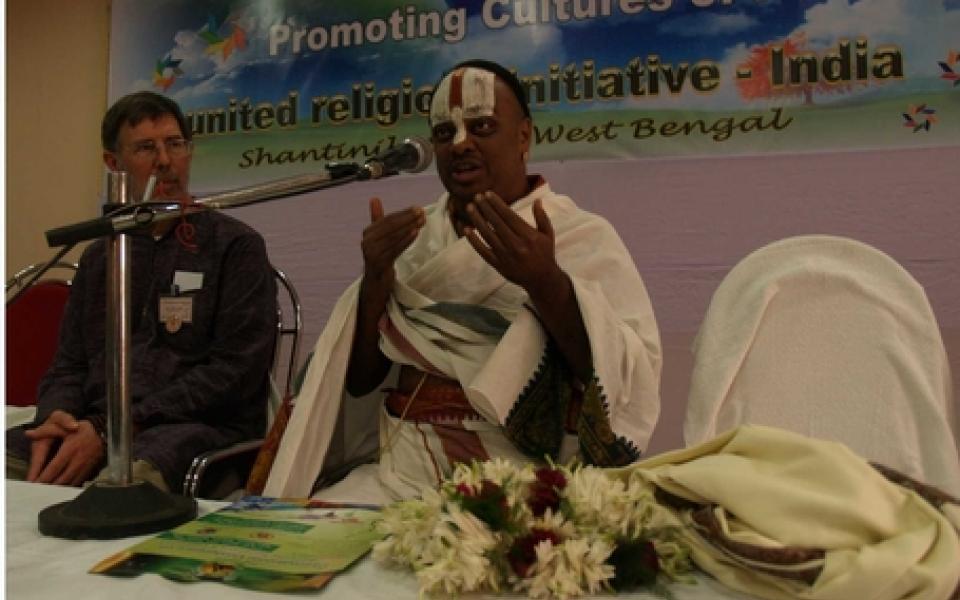
Dear Friends,
Greetings of love and peace from Shantiniketan.
Swami Chaturvedi (pictured above) arrived before the media had left, so they also had the opportunity to hear from him. (Since we worked late into the night on Sunday, I am writing early Monday morning. There was just a knock on my door. When I opened, I was greeted with a cheery, “Good morning, sir, chai,” and handed a cup of steaming tea. I must have missed this yesterday when I was out walking. Also, Biswadeb informed us that the press conference yielded significant TV and other coverage.)
Drawing on the theme – Promoting Cultures of Peace – Swamiji gave a virtuoso talk about believing in and training for peace. Blessed with both a brilliant mind and a great heart, he speaks extemporaneously at a rapid clip, laying out an intricately structured, alliterative, informative, challenging and inspiring message. He said we must work with a constant approach and great zeal to create peace because it is the divine will. He called it the “trans-religious responsibility of religion” to promote amity, harmony and mutual understanding, noting that we work with inevitably limited resources for an unlimited master.
In our efforts to build peace, we must turn to nature for nourishment and inspiration to help us promote peace in ourselves and be agents for peace in the social, religious and political arenas, with a special mention of combating state-sponsored terrorism. As people of faith, we must be active – “Religions should not be in solitary confinement.” We are all called to heaven. Our homework from the Divine, who has made us to be peace, is to cooperate in building heaven in this world so we are prepared to inhabit heaven when we leave this world.
He spoke about six skills/dimensions of peacebuilding as we seek to move from conflict to tolerance to fraternity to brotherhood:
• Living with difference without interference
• Engaging in dialogue to understand difference
• Preventing and/or settling disputes that arise from difference
• Engaging in dialogue to understand similarities
• Creating awareness of a Common Binding Interest as a pool of potential and applying it
• Achieving unity while working in a social continuum that includes the helpless, exploiters and relievers.
He then offered some practical steps:
• Keep a daily peace journal chronicling the work you do for peace
• Lobby the government to issue identity cards to trained peacebuilders that would provide access to areas of conflict and the opportunity to negotiate/mediate conflicts
• Work for justice by engaging the masses, those in power and the media
• Create our own proactive agenda of peacebuilding
• Teach how we are united in a divine knot, a common web of destiny
• Create peace guides, manuals and a syllabus
• Promote peace walks, peace sports, peace festivals, peace fairs
• Create peace abodes and peace tourism (going into conflicted areas in witness to peace)
• Create an eJournal, prime time TV programing and advertisements dedicated to peace to foster a mass movement and influence policy makers
We must create positive potential, shed our reluctance and dream and act big.
Swamiji finished his talk saying that the metrics to evaluate the effectiveness of his presentation will come a year from now as people report on the enhanced efforts they have made to be peacebuilders.
He and I spoke at some length after the talk and group photos. He’s eager to help build URI in India and eager to have me return in 2013 with the sole focus of traveling to several cities to meet with high-level people who can provide financial support for this work. He also has thoughts about a URI India membership program that might create a broad funding base; and he is interested in building a URI temple in India. Abraham will follow up on these possibilities. Swamiji also committed to Biswadeb (Chakraborty, URI's Subregional Coordinator for India's East Zone) to fully fund the meeting space, room and board for 250 participants for the 2013 assembly as a site outside of Mumbai!
After Sunday lunch, we walked in three groups to the Shantiniketan campus where we toured the Tagore Museum, the houses Tagore had built and the extensive grounds of his compound, which is embedded in a much larger university campus. A special moment was standing at the tree where Tagore’s father had a vision – People of all faiths go to their temples or mosques or gurudwaras or churches to worship the God they know. May people come here to this tree to worship God as one. The light of that vision, which flowed so clearly through Rabindranath Tagore, was palpable and profoundly inspiring, all the more so because my companions for most of the walk were young students from the Karickham International School in south India. I first met them over a year ago and was delighted to see that they were part of a contingent that made the three-day train trip from Kerala to this assembly.
Near the close of the afternoon, we gathered for an extended sharing of reflections on the tour of Shantiniketan. I was moved by the outpouring of deep inspiration people had received, most of them on their first visit to the home and university of this icon of Indian enlightenment. We closed the afternoon with Muslim prayers.
In the evening, the Karickham school young women and men sang beautifully as part of a cultural program that included a stirring song for the rights of tribal people sung by a group of tribal men who have dedicated their lives to this cause. The culmination of the evening was a performance by three members of Ektaan Cooperation Circle, a cross-caste, inter-religious group of musicians who use music as a platform for social change. Founder Biswadeb Chakraborty informed us that Ektaan now has a membership of over 5,000 musicians! Renowned singer, Ashis Paul, whom I first met in Kolkata many years ago and who performed at the URI Global Assembly in Mayapur in 2010, electrified the audience with his songs.
Woven through the day were conversations about the women’s initiative pilot project for India for 2013 and the vision of an environmentally focused interfaith dimension to the historic Kumba Mela (130 million people expected!) which will overlap with World Interfaith Harmony Week this coming February. Might this vision help galvanize and unite observances of WIFW throughout URI’s global network by calling us all to have local projects aimed to help heal and protect the Earth for present and future generations? Stay tuned!
That’s a partial report of a day full to overflowing. I’ll end with another quote from Tagore:
Faith is the bird that feels the light and sings when the dawn is still dark.
Blessing,
Charles
The Rev Canon Charles P. Gibbs
Executive Director, United Religions Initiativ

